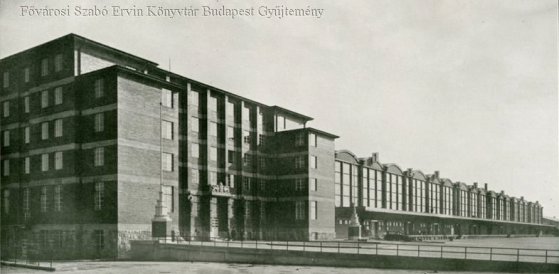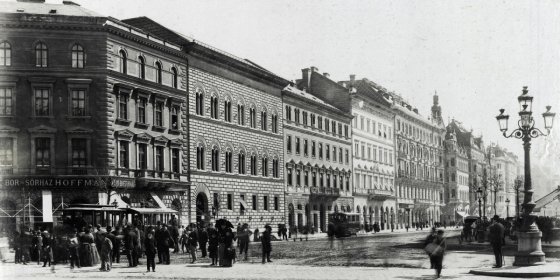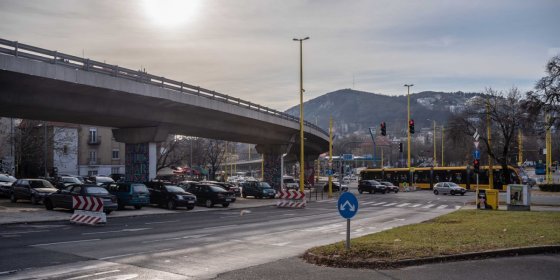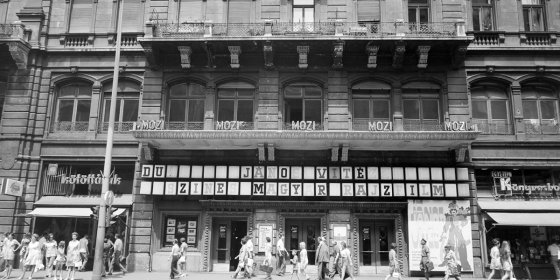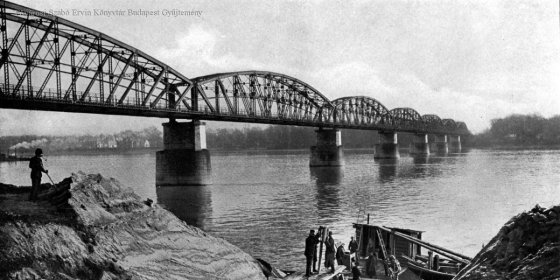 The „intertwined history” of the bridges and the city of Budapest
Which ideas and events have shaped the fate of bridges of Budapest and the cityscape? Alongside many other interesting facts, this question is also answered this newly published book by the Budapest City Archives, which introduces the history of bridges in Budapest.
The „intertwined history” of the bridges and the city of Budapest
Which ideas and events have shaped the fate of bridges of Budapest and the cityscape? Alongside many other interesting facts, this question is also answered this newly published book by the Budapest City Archives, which introduces the history of bridges in Budapest.
histories
 The German Theatre in Pest, once the largest theatre in the city, burned down 175 years ago
The German Theatre in Pest, once the largest theatre in the city, burned down 175 years ago
February 4, 2022 at 9:00 AM
The side of today's Vörösmarty Square facing the Danube has been lined with many buildings over the past 200 years, the first being the German Theatre in Pest [Pesti Német Színház], which was handed over in 1812. Although excellent Hungarian artists of the time also performed in the huge building, which could accommodate 3,500 spectators, such as Déryné and its second conductor was Ferenc Erkel himself, however, the theater could only be used for 35 years, as it burned down on 2 February 1847.
The tram started on the Várkert Embankment 115 years ago
February 1, 2022 at 9:00 AM
The tramway at the Chain Bridge bypasses the Buda end of the bridge in a tunnel, under the ground. However, when it was built, the tramway was debated for 9 years by the Budapest City Council and the Budapest Public Works Council, it was difficult for them to decide whether to run the tram on the upper or lower embankment. In the end, the dispute was concluded, so 115 years ago, in 1907, trams could start south of the Chain Bridge.
When gas no longer came from the factory - This is how Budapest switched to the new heating method
January 31, 2022 at 10:00 AM
In Budapest, it has been decided for half a century to displace air-polluting coal heating from the city centre and switch to gas. At that time, two types of gas were used in households: town gas made of coal and natural gas. Over time, however, the former has been increasingly displaced by more efficient natural gas, which has required the rebuilding of networks and the replacement of gas appliances. Fifty years ago, in 1972, the changeover received a great deal of momentum, but it was accompanied by casualties: the days of the Óbuda Gas Factory, which produced town gas, were numbered since then.
They were looking for the old Pest city walls after a pipe burst in Pest
January 28, 2022 at 9:00 AM
Pipe bursts occur. Sometimes they are just unpleasant, sometimes they cause serious damage, and rarely do they lead to interesting discoveries. This happened in the city centre, where in 1972, following a pipe burst, it was believed that a section of the old Pest city wall had come to light.
Buses appeared on the Outer Ring Road ninety years ago - the public could travel for free on the first one
January 25, 2022 at 9:00 AM
The tram has belonged to the scenery of the outer ring road for almost a quarter of a century now. Traffic on the ring road is unthinkable without it, but there was a time when trams were not enough, so from 1932, for 57 years, buses also ran on the Outer Ring Road. They started on 25 January, 1932, just 90 years ago.
Városliget Bridge and Margit Island Water Tower - Budapest owes much to Szilárd Zielinski
January 18, 2022 at 9:00 AM
The first Hungarian doctor of engineering was appointed 120 years ago, on 17 January 1902. He was Szilárd Zielinski, who, in addition to writing his doctoral dissertation on a railway system under Budapest, was one of the pioneers of reinforced concrete construction and provided the city with a number of emblematic structures. Without him, the Margit Island Water Tower, the bridge named after him over Lake Városliget, but also the Chain Bridge would be different.
Palatine Joseph, who died 175 years ago, had been systematically developing Budapest for decades before the Public Works Council
January 15, 2022 at 3:30 PM
Palatine Joseph [József nádor in Hungarian] died 175 years ago in Buda. Although the archduke born in Florence was destined for a different career, he did much for Hungary, Pest and Buda from 1795 as a governor, then from 1796 as Palatine until his death in 1847. On the anniversary of his death, we put together a bouquet of what Budapest owes to him.
The past of Nagyvásártelep - The food trade centre of the capital was built ninety years ago
January 6, 2022 at 9:00 AM
When the Central Market Hall in Fővám Square was handed over in 1897, the leaders of the city believed that the process of food industry development and freight transport, which had been going on for decades at the time, had come to an end. Steam mills, slaughterhouses and meat plants were lined up along Soroksári Road, and the needs of retailers and wholesalers were fully met with the establishment of the Danube Coast Freight Station and the construction of public warehouses between the Southern Railway Link Bridge and Fővám Square. However, it soon became clear that this was far from the case, and there was an urgent need to ensure the daily flow of goods through a wholesale market.
Cars were banned from the popular streets of the Downtown 45 years ago
January 5, 2022 at 11:00 AM
In Budapest, from the 1960s onwards, the narrow streets of the Downtown were completely occupied by cars and barely accessible to pedestrians. At first, cars were banned only from Váci Street, but 45 years ago, car traffic was stopped in several Downtown streets, and from then on, only pedestrians could use them.
The Fashion Hall moved to Andrássy Avenue out of necessity - The store opened in its new location sixty-five years ago
January 2, 2022 at 3:00 PM
The Magyar Divatcsarnok [Hungarian Fashion Hall] moved from Rákóczi Road to Andrássy Avenue in 1957, to the former building of the Párisi Nagy Áruház [Párisi Department Store], which was nationalized after the war and used as a book storage. In the 1956 revolution, the store of the Fashion Hall at 72 Rákóczi Road was so damaged that a new location had to be found. The building on Andrássy Avenue was available, only 10 wagons of unsold books had to be disposed of.
Forty years ago, private taxis appeared on the streets of Budapest
January 1, 2022 at 10:00 AM
In the 1980s, the private sector also played an increasingly important role in the socialist system. The change in taxiing came 40 years ago, and private taxis have been able to work in the capital since 1982. At first, the passengers were transported by Ladas, Zastavas and Dacias.
The last coronation - Charles IV became a Hungarian king 105 years ago
December 30, 2021 at 9:00 AM
During the bloodthirsty years of World War I, the difficult fate of the Austro-Hungarian Empire was compounded by another blow at the end of 1916: Emperor and King Franz Joseph I died. After sixty-eight years of rule, he passed away on 21 November 1916. He was succeeded by his grandnephew, Archduke Charles of Habsburg-Lorraine, who had been crowned king on 30 December 1916, 105 years ago.
Who put the country on the train - Budapest owes a lot to Gábor Baross, former Minister of Transport
December 29, 2021 at 6:00 PM
Gábor Baross, who was Minister of Transport for only 6 years, was appointed 135 years ago. He was the one who put the country on the train: by establishing cheap rail travel, it made Budapest accessible to low-income country people, helping the development of the capital a lot.
It was once a famous ice rink in Buda, today it is one of the busiest junctions in the country
December 29, 2021 at 11:00 AM
Ice skating is one of the most popular winter sports done by many in Budapest. Few people know, but one of the busiest junctions in the country, Széll Kálmán Square, was once home to a famous and very popular ice rink in Buda with a huge, richly decorated skating hall. By the end of the 1930s, the square had been completely transformed and today we only have pictures and stories of the former famous skating rink and sports fields in Buda.
Traffic lights have been with us for 95 years - The first traffic light was installed on Blaha Lujza Square
December 27, 2021 at 12:00 PM
Nowadays, we take it for granted that traffic lights are included in the cityscape. They switch automatically, or pedestrians may have to press a button to cross. The predecessor of today's traffic lights were still manually operated, and the first one appeared at the corner of the Outer Ring Road and Rákóczi Road 95 years ago.
The first gas lamps in Pest were lit 165 years ago
December 23, 2021 at 10:00 AM
At night in Budapest, thousands of gas lamps once provided light, which had to be lit one by one by the lamplighters every night and then extinguished at dawn. The gas lamps lived their heyday in the second half of the 19th century, the first street gas flames in Pest were lit on today's Rákóczi Road 165 years ago.
Residential buildings were also demolished due to the construction of the 45-year-old BAH junction overpass
December 20, 2021 at 9:00 AM
The 660-meter overpass above the BAH junction plays an indispensable role in the traffic of Budapest, as it is actually the gateway to Lake Balaton. The huge bridge was built 45 years ago, and since then tens of millions of people have crossed it to reach Lake Balaton or the Adriatic. However, the construction also came at a price: a total of 73 flats disappeared due to it, and the old customs house was also demolished.
Disaster tourists in the 19th century - Crowds gathered to the cry of unfortunate construction workers in Ferenciek Square
December 18, 2021 at 10:30 AM
After the unification of the city, construction works in Budapest started at a dizzying pace, huge, multi-storey houses were erected in a few months, but accidents on construction sites were rare. One of these happened during the construction of the Ferenciek Bazaar, when a falling wall buried eight workers. At the wailing of the injured, the people of Pest flooded the area in no time. Our reminiscent article gives an insight into how the authorities dealt with construction accidents in the 19th century.
The Home of Hungarian Teachers is still standing today - Teachers living in poor conditions could move into the tower building
December 17, 2021 at 10:00 AM
At the beginning of Orczy Road, close to Nagyvárad Square, stands a house with a tower, reminiscent of a medieval castle, quietly hiding behind the surrounding trees. Few know that this building once served as the home of the poor teaching women in the capital.
Erzsébetváros was the poorest and smallest district but it wanted to take the name of the Queen
December 16, 2021 at 3:00 PM
The 7th District is a relatively young part of the city, it was separated from Terézváros in 1873, because that was found to be too large and too populous. The new district thus created became the smallest part of Budapest, but at that time it did not have its own name. However, the leadership of the district, which began to develop vigorously in the second half of the 19th century, believed that identity requires a name, so in December 1881, they asked the royal couple to let the district take the name of Queen Elizabeth.
The first new train of the Millennium Underground was unveiled 50 years ago
December 13, 2021 at 9:00 AM
Today's Millennium Underground vehicles have appeared in Budapest's tram lines 50 years ago. Yes, on the surface, because the first prototypes were tested on tram lines. Why were new vehicles needed 50 years ago and how were they made?
Sweet life in happy times of peace - The Stühmer Factory from foundation to nationalisation
November 29, 2021 at 11:30 AM
Tibi chocolate, Ropp wafer and Zizi dragee. Generations have known and loved the popular products of the Stühmer Chocolate Factory. How did Frigyes Stühmer create Hungary's first and largest chocolate factory in Józsefváros during the Compromise-period and why did the factory have to move to the neighbouring Ferencváros? The factory was nationalised after World War II, and descendants who moved to Canada tried unsuccessfully to reclaim it in the 1990s, yet the brand name, founded more than 150 years ago, has not been forgotten.
The Fórum film theatre, the forerunner of Puskin cinema, opened 95 years ago
November 25, 2021 at 10:00 AM
The building, which houses the Puskin Cinema and was built in 1895 according to the plans of Czigler Győző, has had a cinema in it since 1926, before which the Magyar Világ Café was located on the ground floor of the building. An audio film was first screened in Hungary at the former Fórum film theatre in 1929, although this was almost thwarted by a patent lawsuit.
The artists' colony on Százados Road was built on the outskirts of the city 110 years ago, today it is an integral part of Józsefváros
November 15, 2021 at 1:00 PM
A special and closed world bordered by a fence where artists live and create. That's how it has been for110 years. With the support of Mayor István Bárczy, the country's first artists' colony was built on Százados Road in 1911 from the budget of the capital, with fifteen one-storey houses and 28 studios. From the beginning, renowned artists created here, including Ferenc Medgyessy, Zsigmond Kisfaludi Strobl, Bertalan Pór, Dezső Czigány. The area, which was still a suburb at the time of its handover, is now an integral part of Józsefváros.
The first Hungarian flew over Budapest 110 years ago
November 12, 2021 at 9:00 AM
One of the most colourful personalities in the heroic age of aviation was Guido Prodam. The adventurous pilot learned to fly in Rákosmező, and he was the first Hungarian to fly over the Budapest downtown 110 years ago. During his journey, he flew along the Danube, he also flew above the Chain Bridge, the Buda Castle and the Technical University.
Right-hand traffic was introduced in Hungary 80 years ago
November 10, 2021 at 9:00 AM
In much of the world today, cars are on the right side of the road, and on the European mainland, this is the traffic regulation, wherever we go. However, this was not always the case: the right-hand drive in Hungary only became common 80 years ago, in November 1941, as one of the last countries on the European continent. However, several transport vehicle still operated according to the original order, the change in the Kisföldalatti [the small underground railway] only took place in 1973.
A forgotten enormous railway bridge - Built for the Millennium, destroyed by war
November 7, 2021 at 10:30 AM
The Újpest Railway Bridge is a stepchild among the bridges in Budapest because it does not even have a regular name. There is almost no mention of it, even though trains have been running here for 125 years, and it plays an important role in traffic around Budapest. Pestbuda now remembers the birth of the first structure, which was built in 1896 for the millennium but was destroyed in World War II.
"Budapest should be made a metropolis" - 150 years ago, the large-scale constructions in the capital were announced
November 4, 2021 at 10:30 AM
The transformation of the Hungarian capital into a metropolis was formulated before the unification of Pest and Buda, when in 1871 a tender was issued for the preparation of a regulatory plan that would provide a framework for the planned large-scale constructions. The tender, which closed 150 years ago, received a number of proposals that contributed to the development of the currently known structure and cityscape of the capital.
Miracle under Buda - The Szemlő-hegyi Cave can be visited for 35 years
November 1, 2021 at 2:00 PM
Although the Szemlő-hegyi Cave has been discovered for more than 90 years, it has only been open to the public for 35 years. This is one of the most beautiful and interesting underground attractions in the capital, which is a great recognition, as there are several cave specialities below Budapest.
Intended to be temporary, the structure of the Connecting Railway Bridge built after the war served Budapest until 2008
October 29, 2021 at 10:00 AM
At the end of World War II, a permanent railway bridge over the Danube was rebuilt at record speed. One and a half years after the weapons were silenced in the country, and exactly 22 months after the bridge was blown up, the semi-permanent structure of the Connecting Railway Bridge was already standing, weighing half as much as the Chain Bridge which is much longer than this. Although it was demolished a few years later from its original location, it moved to Újpest, where it served traffic until recently.
More articles
 The „intertwined history” of the bridges and the city of Budapest
Which ideas and events have shaped the fate of bridges of Budapest and the cityscape? Alongside many other interesting facts, this question is also answered this newly published book by the Budapest City Archives, which introduces the history of bridges in Budapest.
The „intertwined history” of the bridges and the city of Budapest
Which ideas and events have shaped the fate of bridges of Budapest and the cityscape? Alongside many other interesting facts, this question is also answered this newly published book by the Budapest City Archives, which introduces the history of bridges in Budapest.
 The Bridge Report, which brought a turning point in the history of Budapest
A travel report that changed the history of Pest and Buda, as well as Hungary. The little book contributed to the change of half a thousand years of legal customs and the implementation of an investment of unprecedented size and technical quality. This book was The Bridge Report [Hídjelentés in Hungarian].
The Bridge Report, which brought a turning point in the history of Budapest
A travel report that changed the history of Pest and Buda, as well as Hungary. The little book contributed to the change of half a thousand years of legal customs and the implementation of an investment of unprecedented size and technical quality. This book was The Bridge Report [Hídjelentés in Hungarian].
 Drama on the university wall - The heroic monument was planned 95 years ago
In the constant hustle and bustle of the Egyetem Square in Pest, the students may not even notice the monument that decorates the short section of wall between the church and the central building of ELTE. However, it commemorates their predecessors, the heroes who fought for their country in World War I, and those who heroically helped them. The first design of the dramatically collapsing soldier was born in 1928, ninety-five years ago.
Drama on the university wall - The heroic monument was planned 95 years ago
In the constant hustle and bustle of the Egyetem Square in Pest, the students may not even notice the monument that decorates the short section of wall between the church and the central building of ELTE. However, it commemorates their predecessors, the heroes who fought for their country in World War I, and those who heroically helped them. The first design of the dramatically collapsing soldier was born in 1928, ninety-five years ago.







